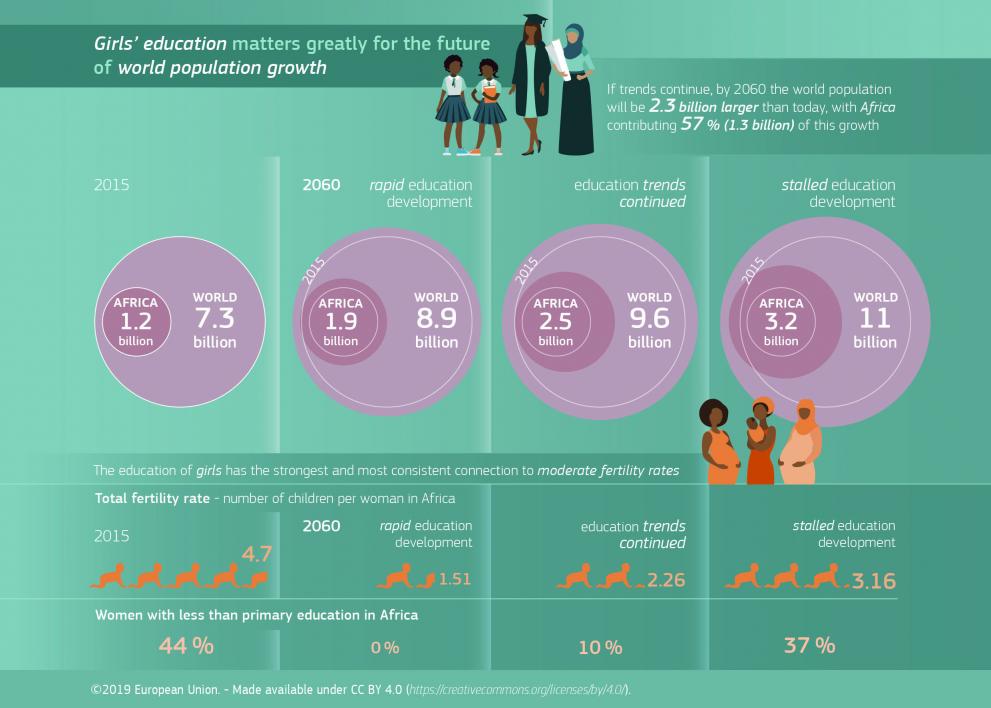- Don’t mention the “P” word!
- The shocking mystery of Kerala, India.
- The mystery explained – and it’s exciting!
- This is where you can get involved – for free!
- Another big factor – vote for this!
Don’t mention the “P” word!
Talking about overpopulation triggers people to think of population control. But the great news is there is no need to suggest a “one child policy” or forced sterilisations or the other horrors people often imagine. Tackling population growth doesn’t even have to involve mentioning the “P” word at all!
But to quickly review the problem – I like this 5 minute video from the American organisation Population Education. They’re a group that produces social sciences material covering overpopulation for high schools. They use the best studies from the UN and other credible sources, but break it down into a digestible format that I like. (There is also an interactive scroll bar map with more clickable information here.)
The shocking mystery of Kerala, India.
Kerala state in India once had very high population growth. Then everything sociologists thought they knew turned upside down! The following quote from Bill McKibben is getting old – it’s from 1995. But I like it because it shows how utterly unexpected Kerala’s social demography turned out to be back then.
But here is the odd part.
- The life expectancy for a North American male, with all his chairs and cushions, is 72 years, while the life expectancy for a Keralite male is 70.
- After the latest in a long series of literacy campaigns, the United Nations in 1991 certified Kerala as 100 percent literate. Your chances of having an informed conversation are at least as high in Kerala as in Kansas.
- Kerala’s birth rate hovers near 18 per thousand, compared with 16 per thousand in the United States–and is falling faster.
Demographically, in other words, Kerala mirrors the United States on about one-seventieth the cash. It has problems, of course: There is chronic unemployment, a stagnant economy that may have trouble coping with world markets, and a budget deficit that is often described as out of control. But these are the kinds of problems you find in France. Kerala utterly lacks the squalid drama of the Third World–the beggars reaching through the car window, the children with distended bellies, the baby girls left to
die…
…It is, in other words, weird–like one of those places where the starship Enterprise might land that superficially resembles Earth but is slightly off. It undercuts maxims about the world we consider almost intuitive: Rich people are healthier, rich people live longer, rich people have more opportunity for education, rich people have fewer children. We know all these things to be true–and yet here is a countercase, a demographic Himalaya suddenly rising on our mental atlas. It’s as if someone demonstrated in a lab that flame didn’t necessarily need oxygen, or that water could freeze at 60 degrees. It demands a new chemistry to explain it, a whole new science.
Utne Reader – from Doubletake 1995.
The mystery explained – and it’s exciting!
I’m quoting from the EU Science Hub on population. This is their summary. The graph is a little confusing at first – but the further right you go, the more catastrophically they’ve failed to install their ‘master plan’ for population control! And what is this sinister plan? Here’s the punchline – and why we do not even need to mention the “P” word at all to have a solution to overpopulation.
Educating all girls is key for global population size – EU Demographic Scenarios
Increasing girls’ education is key for the future of population growth in Africa and the world
- If trends continue as they are now, the world population will reach 9.6 billion people in 2060.
- The global population growth is highly impacted by population growth in Africa.
- Improvements in reproductive health and female education can work together to lower the desired family size and make it easier to get access to efficient contraception, leading to lower fertility.
- The payoff is high for policies focusing on education, because it both reduces fertility and increases skills and economic productivity. This could create a virtuous circle of women’s empowerment, better health, lower fertility and economic growth.

That’s it! Educate and empower girls! Here’s another source. The United Nations Population Fund website has a fun design that reminds me of the 1990’s Cyberpunk novels I used to read. Even though the UN currently models a higher population than Earth4all above, they still conclude:-
This means focusing on investments in education, health care, clean and affordable energy and working towards gender equality, rather than trying to reduce the number of people on our planet.
UNFP “Too Many”
Why? Because they know that meeting all all our physical and educational and empowerment needs stabilises the population. They know these factors create the demographic transition (see wiki for more). There’s no global conspiracy to sterilise anyone or install a “One Child Policy” or such dystopian ideas. Educate and empower girls – especially in Africa. That’s it!
This is where you can get involved – for free!
For the last few decades our family have sponsored little girls around the world. In Australia (and probably other industrialised nations) this is even tax deductible. You get your money back as a tax refund. You can have a direct impact on a little girl’s education and empowerment. She can then be more equipped to directly contribute to her local village or town or city. But indirectly – you will also most likely be helping her local environment and economy not spin out of control with overpopulation pressures. Sponsor children – especially girls – especially in Africa. Because of population pressures – but also because it’s the right thing to do anyway!
Another big factor – vote for this!
This next report comes from the Earth4all.life group. This is a huge group! (I referenced the Potsdam Institute many times on my Planetary Boundaries page.)
Earth4All is a vibrant collective of leading economic thinkers, scientists, and advocates, convened by The Club of Rome, the BI Norwegian Business School, the Potsdam Institute for Climate Impact Research and the Stockholm Resilience Centre.
Building on the legacies of The Limits to Growth and the Planetary Boundaries frameworks, science is at the heart of our work. Leading scientists have developed state of the art systems dynamic models and run different scenarios for possible plausible futures.
They disagree with the United Nations and think more accurate demographic modelling around educating girls and some tweaking to global income models might actually allow faster demographic decline.
They model that current taxation and social policies might “limit global population growth to below 9 billion in 2046 and then decline to 7.3 billion in 2100…” – but then go further to model if us activists get together and demand some more vigorous economic support of certain welfare programs. Here is what they conclude.
In the second, more optimistic scenario – with governments across the world raising taxes on the wealthy to invest in education, social services and improved equality – it estimates human numbers could hit a high of 8.5 billion as early as 2040 and then fall by about a third to about 6 billion in 2100. Under this pathway, they foresee considerable gains by mid-century for human society and the natural environment.
“By 2050, greenhouse gas emissions are about 90% lower than they were in 2020 and are still falling,” according to the report. “Remaining atmospheric emissions of greenhouse gases from industrial processes are increasingly removed through carbon capture and storage. As the century progresses, more carbon is captured than stored, keeping the global temperature below 2C above pre-industrial levels. Wildlife is gradually recovering and starting to thrive once again in many places.”
The Guardian, March 2023
Imagine that? We have to complete the energy transition by 2050 for climate reasons. Imagine a world of abundant clean energy and a population of 6 billion by 2100? Why – that gives them a chance to discover what truly long term sustainability might look like. What a fantastic vision. Now that’s something I can fight for!


How large a human population can the Earth sustain? That depends on what condition we leave the Earth in. Had we stopped pop-growth back in, say 1960, we might have been able to creep up to 4B or 5B people sustainably today. But we didnt’. If we do not stop pop-growth until after the rain-forests are gone, and insect diversity is devastated, then we might be lucky to have the Earth sustain 1B. And a very bleak Earth it will be.
Yes, good point Pyrotex… I hope my argument above doesn’t sound like I’m recommending we try and stuff as many human beings on the planet as we can! I guess I’m just trying to look realistically at the trends, and what might happen as a result and where we can find good solutions in the “T” in I=PAT.
Cheers!
Pingback: Reduce population growth | Eclipse Now